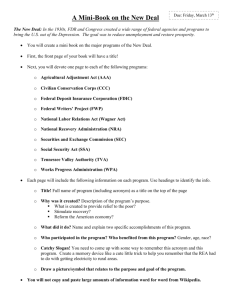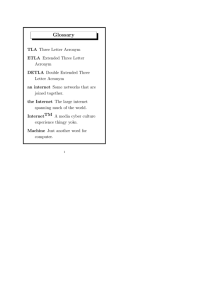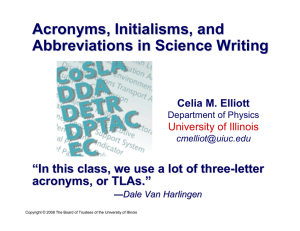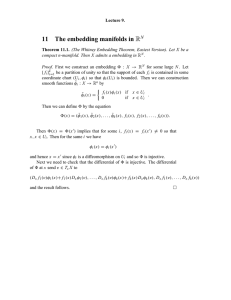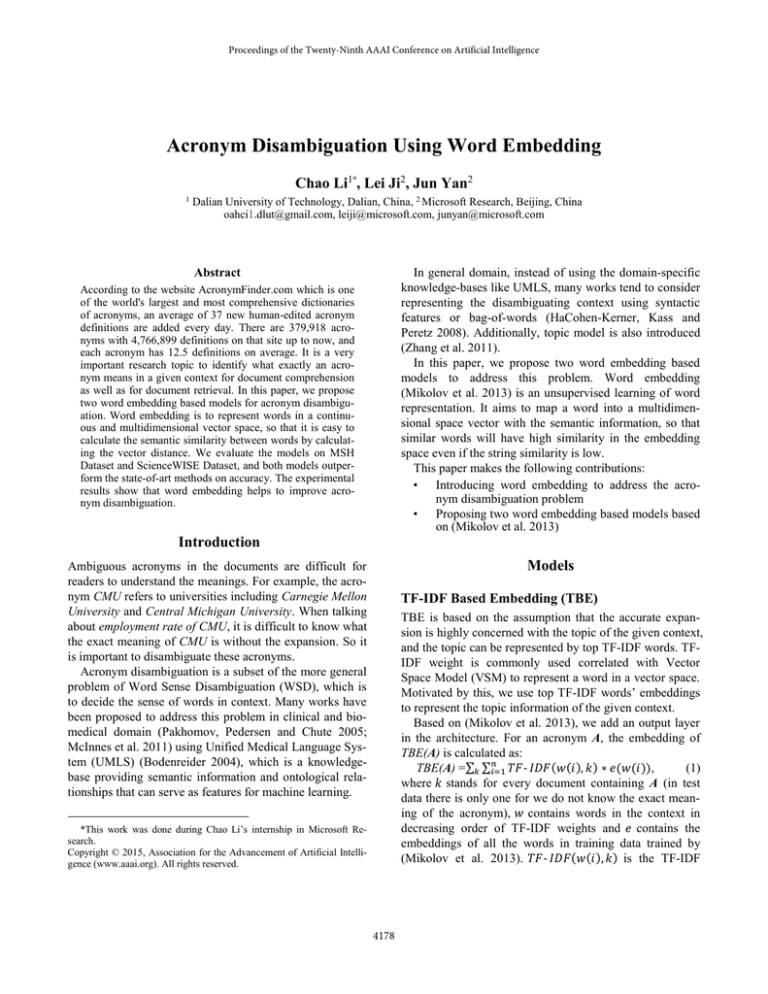
Proceedings of the Twenty-Ninth AAAI Conference on Artificial Intelligence
Acronym Disambiguation Using Word Embedding
Chao Li1*, Lei Ji2, Jun Yan2
1
Dalian University of Technology, Dalian, China, 2 Microsoft Research, Beijing, China
oahcil.dlut@gmail.com, leiji@microsoft.com, junyan@microsoft.com
Abstract
In general domain, instead of using the domain-specific
knowledge-bases like UMLS, many works tend to consider
representing the disambiguating context using syntactic
features or bag-of-words (HaCohen-Kerner, Kass and
Peretz 2008). Additionally, topic model is also introduced
(Zhang et al. 2011).
In this paper, we propose two word embedding based
models to address this problem. Word embedding
(Mikolov et al. 2013) is an unsupervised learning of word
representation. It aims to map a word into a multidimensional space vector with the semantic information, so that
similar words will have high similarity in the embedding
space even if the string similarity is low.
This paper makes the following contributions:
• Introducing word embedding to address the acronym disambiguation problem
• Proposing two word embedding based models based
on (Mikolov et al. 2013)
According to the website AcronymFinder.com which is one
of the world's largest and most comprehensive dictionaries
of acronyms, an average of 37 new human-edited acronym
definitions are added every day. There are 379,918 acronyms with 4,766,899 definitions on that site up to now, and
each acronym has 12.5 definitions on average. It is a very
important research topic to identify what exactly an acronym means in a given context for document comprehension
as well as for document retrieval. In this paper, we propose
two word embedding based models for acronym disambiguation. Word embedding is to represent words in a continuous and multidimensional vector space, so that it is easy to
calculate the semantic similarity between words by calculating the vector distance. We evaluate the models on MSH
Dataset and ScienceWISE Dataset, and both models outperform the state-of-art methods on accuracy. The experimental
results show that word embedding helps to improve acronym disambiguation.
Introduction
Models
Ambiguous acronyms in the documents are difficult for
readers to understand the meanings. For example, the acronym CMU refers to universities including Carnegie Mellon
University and Central Michigan University. When talking
about employment rate of CMU, it is difficult to know what
the exact meaning of CMU is without the expansion. So it
is important to disambiguate these acronyms.
Acronym disambiguation is a subset of the more general
problem of Word Sense Disambiguation (WSD), which is
to decide the sense of words in context. Many works have
been proposed to address this problem in clinical and biomedical domain (Pakhomov, Pedersen and Chute 2005;
McInnes et al. 2011) using Unified Medical Language System (UMLS) (Bodenreider 2004), which is a knowledgebase providing semantic information and ontological relationships that can serve as features for machine learning.
TF-IDF Based Embedding (TBE)
TBE is based on the assumption that the accurate expansion is highly concerned with the topic of the given context,
and the topic can be represented by top TF-IDF words. TFIDF weight is commonly used correlated with Vector
Space Model (VSM) to represent a word in a vector space.
Motivated by this, we use top TF-IDF words’ embeddings
to represent the topic information of the given context.
Based on (Mikolov et al. 2013), we add an output layer
in the architecture. For an acronym A, the embedding of
TBE(A) is calculated as:
TBE(A) =∑𝑘 ∑𝑛𝑖=1 𝑇𝐹‐ 𝐼𝐷𝐹(𝑤(𝑖), 𝑘) ∗ 𝑒(𝑤(𝑖)),
(1)
where 𝑘 stands for every document containing A (in test
data there is only one for we do not know the exact meaning of the acronym), 𝑤 contains words in the context in
decreasing order of TF-IDF weights and 𝑒 contains the
embeddings of all the words in training data trained by
(Mikolov et al. 2013). 𝑇𝐹‐ 𝐼𝐷𝐹(𝑤(𝑖), 𝑘) is the TF-IDF
*This work was done during Chao Li’s internship in Microsoft Research.
Copyright © 2015, Association for the Advancement of Artificial Intelligence (www.aaai.org). All rights reserved.
4178
weight for word 𝑤(𝑖) in document 𝑘. We choose top 𝑛 TFIDF words in the model.
constructed while in ScienceWISE the ontology is manually built, as mentioned in (Prokofyev et al. 2013). The results show that our models perform high accuracy than that
of (Prokofyev et al. 2013).
Surrounding Based Embedding (SBE)
In (Mikolov et al. 2013), sum of embeddings of the surrounding words is used in the hidden layer to calculate the
embedding of the certain word. Motivated by this, we propose SBE to represent the word by adding its surrounding
words’ embeddings, which can enrich the semantic information.
In SBE, we also add an output layer based on (Mikolov
et al. 2013). For an acronym A, the embedding of SBE(A)
is calculated as:
SBE(A) = ∑𝑘 ∑𝑘+𝑖
(2)
𝑗=𝑘−𝑖 𝑒(𝑤′(𝑗)) , 𝑗 ≠ 𝑘,
where 𝑘 stands for every position that acronym A appears
(maybe not in one single document in training data), 𝑖 is
the word window, 𝑤′contains words in the document in the
original order and 𝑒 is the same as that in TBE.
Table 1: Precision for models on the two datasets
Approach
Random (Baseline)
Most Frequent (Baseline)
Context Vectors (Baseline)
NB (Baseline)
Binary CCV (Prokofyev et al.
2013)
Binary CCV+NN (with Cat)
(Prokofyev et al. 2013)
TBE(ours)
SBE(ours)
MSH
46.73
43.60
95.29
67.31
90.77
ScienceWISE
39.37
74.46
74.29
85.13
93.34
90.60
94.53
90.98
93.10
91.56
94.86
Conclusion
Experiment
The experimental results show that using word embedding
can improve the accuracy of acronym disambiguation
without any knowledge-bases, and the results are also very
stable in datasets from different domains. We will focus on
using word embedding to address the general WSD problem in the future.
Datasets & Experiment Setting
We evaluate our models on MSH Collection and ScienceWISE Collection shared by (Prokofyev et al. 2013) which
are both collections of scientific abstracts containing ambiguous acronyms. We apply our models on the same training and test data as (Prokofyev et al. 2013). The MSH dataset contains 7,641 abstracts in training data and 3,631
abstracts in test data, while the ScienceWISE dataset contains 2,943 abstracts in training data and 2,267 abstracts in
test data. We do the following pre-treatments:
• For both training and test datasets, we remove all
the marks and stop-words
• For training dataset, we replace all the acronym and
expansions with the “Acronym+ID,” in which ID is
the index of the meaning to distinguish different
meanings
• For test dataset, we replace all the expansion with
the acronym
Then, we apply our models on the datasets to get the
embeddings of acronyms (in TBE we use top 20 TF-IDF
words, in SBE the word window is 3). We disambiguate
the acronyms in test data by calculating cosine similarity to
choose the most similar one from the given candidates.
References
Bodenreider O. The unified medical language system (UMLS):
integrating biomedical terminology[J]. Nucleic acids research,
2004, 32(suppl 1): D267-D270.
HaCohen-Kerner Y, Kass A, Peretz A. Combined one sense disambiguation of abbreviations[C]//Proceedings of the 46th Annual
Meeting of the Association for Computational Linguistics on
Human Language Technologies: Short Papers. Association for
Computational Linguistics, 2008: 61-64.
McInnes B T, Pedersen T, Liu Y, et al. Using second-order vectors in a knowledge-based method for acronym disambiguation[C]//Proceedings of the Fifteenth Conference on Computational Natural Language Learning. Association for Computational
Linguistics, 2011: 145-153.
Mikolov T, Sutskever I, Chen K, et al. Distributed Representations of Words and Phrases and their Compositionality[J]. arXiv
preprint arXiv:1310.4546, 2013.
Pakhomov S, Pedersen T, Chute C G. Abbreviation and acronym
disambiguation in clinical discourse[C]//AMIA Annual Symposium Proceedings. American Medical Informatics Association,
2005, 2005: 589.
Prokofyev R, Demartini G, Boyarsky A, et al. Ontology-Based
word sense disambiguation for scientific literature[M]//Advances
in Information Retrieval. Springer Berlin Heidelberg, 2013: 594605.
Zhang W, Sim Y C, Su J, et al. Entity Linking with Effective
Acronym Expansion, Instance Selection, and Topic Modeling[C]//IJCAI. 2011, 2011: 1909-1914.
Experimental Results
We compare our models with the results of (Prokofyev et
al. 2013), which also use ontologies as knowledge-bases.
Table 1 shows the results including the baselines. The reason why the baseline Context Vectors performs so well in
MSH dataset can be explained by the relatively low quality
of its background ontology which has been automatically
4179


